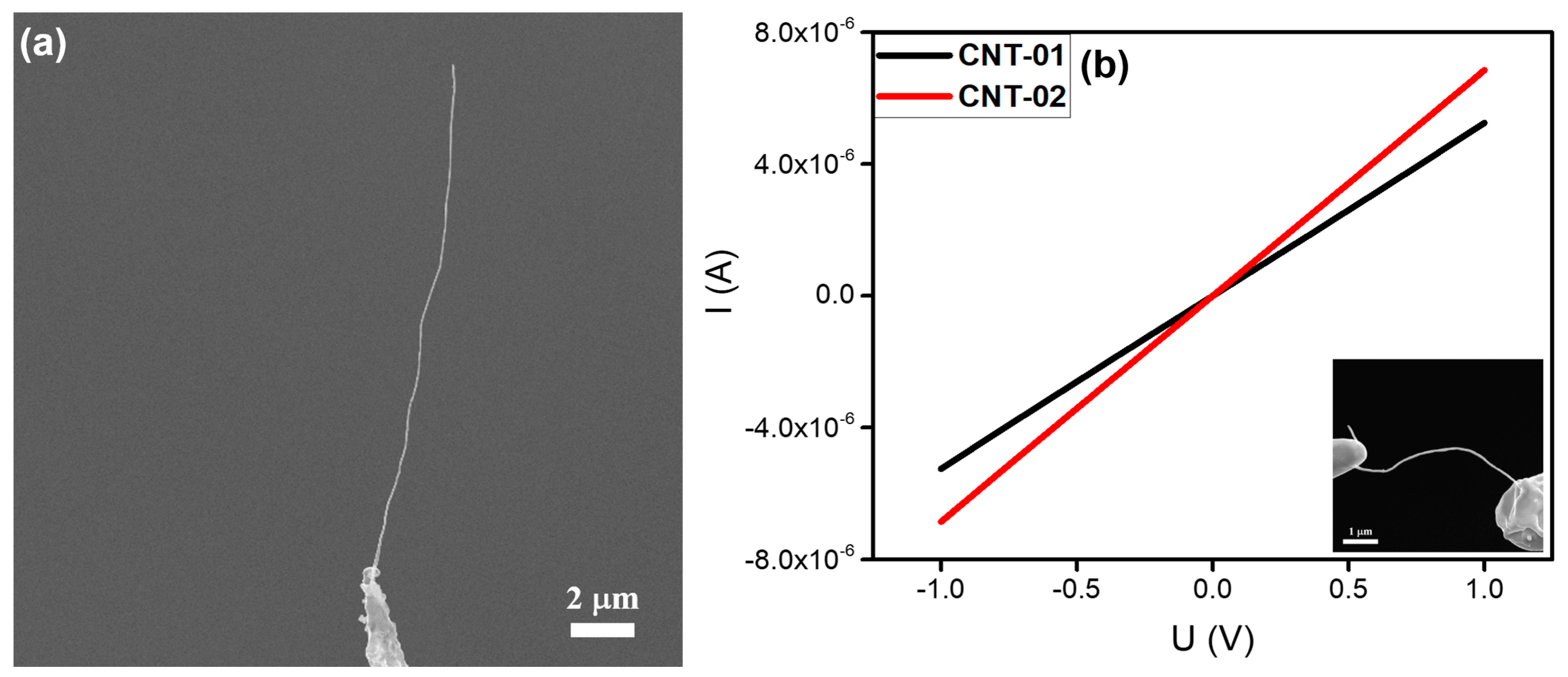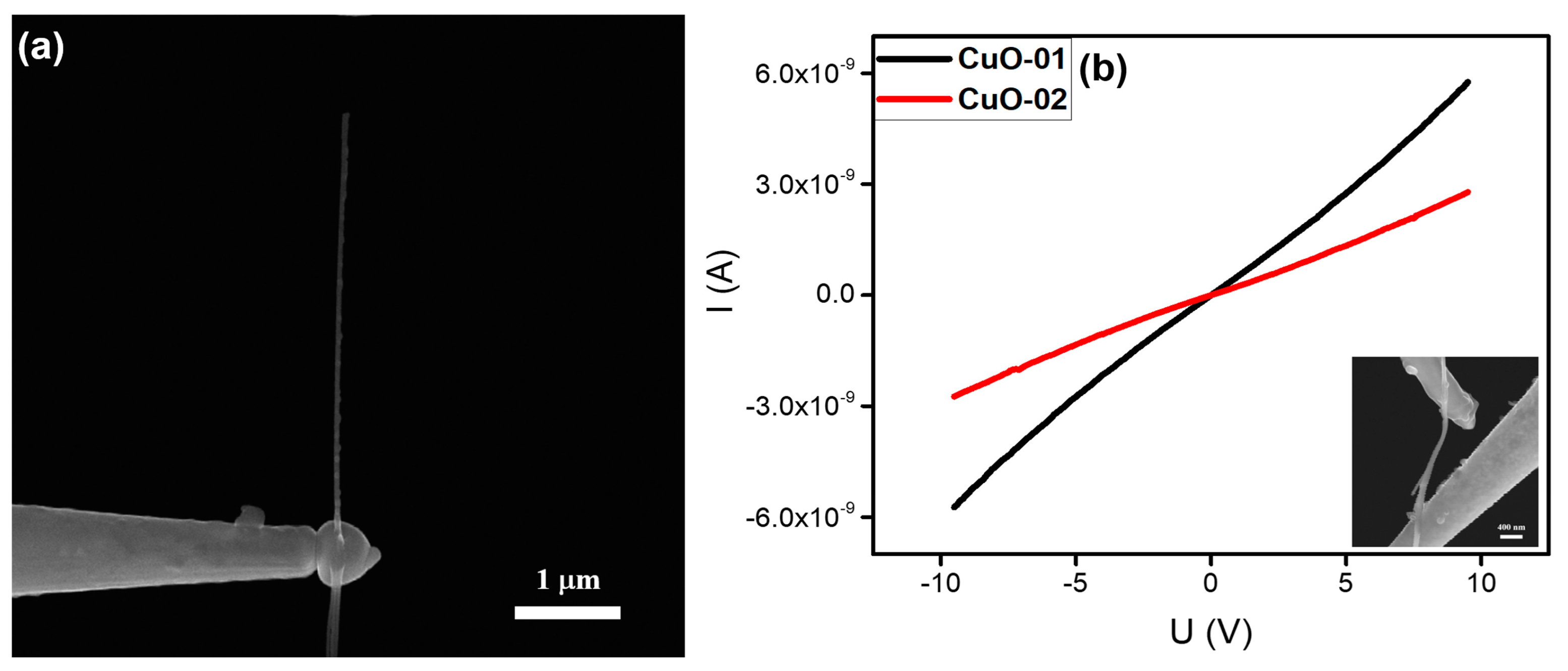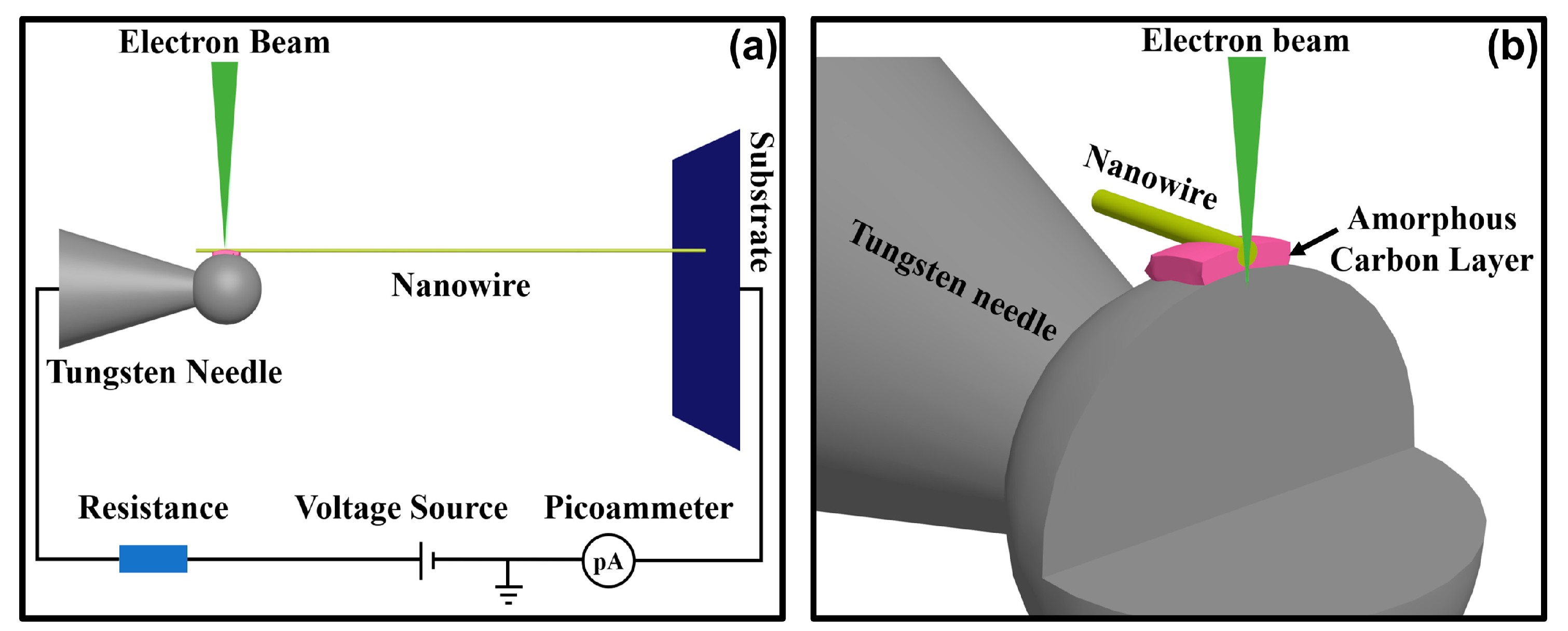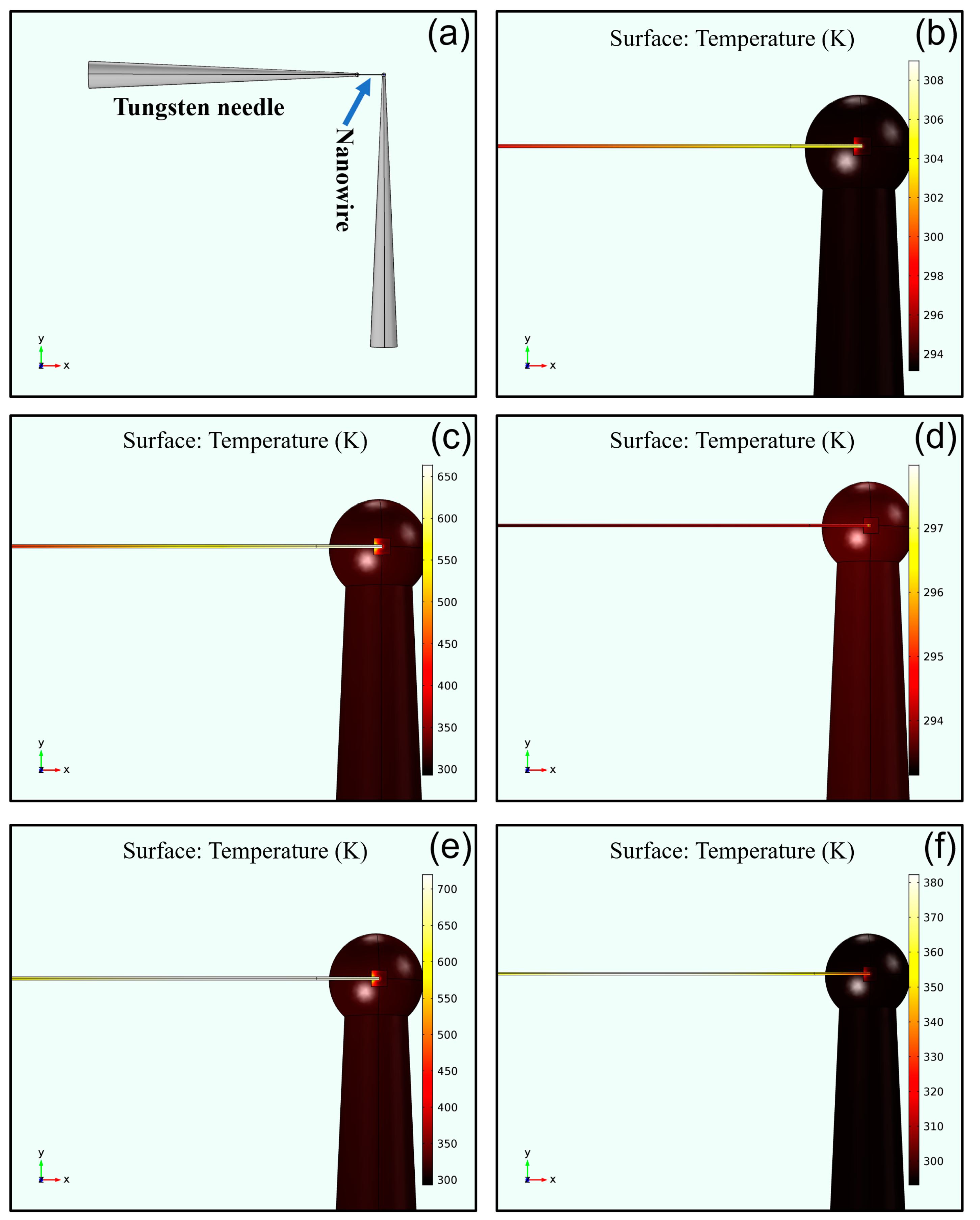A Universal Method to Weld Individual One-Dimensional Nanostructures with a Tungsten Needle Based on Synergy of the Electron Beam and Electrical Current
Abstract
:1. Introduction
2. Experimental Section
2.1. Nanostructure Welding Processes, Morphology Characterizations, and Element Analysis of Individual 1D Nanostructure
2.2. In-Situ Electrical Measurement of Individual 1D Nanostructure in an SEM
2.3. Simulation Methods
3. Results and Discussion
3.1. Welding Process of Individual 1D Nanostructures with Different Orientations
3.2. Electrical Properties of the Individual 1D Nanostructures.
3.2.1. LaB6 Nanowire
3.2.2. CNT
3.2.3. ZnO Nanoneedle
3.2.4. SiC Nanowire
3.2.5. CuO Nanowire
3.3. Theoretical Analysis of the Nanostructure Welding Process of the Individual 1D Nanostructure
3.3.1. Effects of Local Joule Heating on Synergy of Electron Beam and Electrical Current
3.3.2. Effects of the Amorphous Carbon Layer by Electron-Beam-Induced Deposition
4. Conclusions
Author Contributions
Funding
Acknowledgments
Conflicts of Interest
References
- Kulmala, T.S.; Colli, A.; Fasoli, A.; Lombardo, A.; Haque, S.; Ferrari, A.C. Self-Aligned Coupled Nanowire Transistor. ACS Nano 2011, 5, 6910–6915. [Google Scholar] [CrossRef] [PubMed]
- Lu, W.; Xie, P.; Lieber, C.M. Nanowire Transistor Performance Limits and Applications. IEEE Trans. Electron Devices 2008, 55, 2859–2876. [Google Scholar] [CrossRef]
- Yao, J.; Yan, H.; Das, S.; Klemic, J.F.; Ellenbogen, J.C.; Lieber, C.M. Nanowire nanocomputer as a finite-state machine. Proc. Natl. Acad. Sci. USA 2014, 111, 2431–2435. [Google Scholar] [CrossRef] [PubMed] [Green Version]
- Shen, G.; Chen, P.-C.; Bando, Y.; Golberg, D.; Zhou, C. Pearl-Like ZnS-Decorated InP Nanowire Heterostructures and Their Electric Behaviors. Chem. Mater. 2008, 20, 6779–6783. [Google Scholar] [CrossRef]
- Zhai, T.; Fang, X.; Liao, M.; Xu, X.; Zeng, H.; Yoshio, B.; Golberg, D. A Comprehensive Review of One-Dimensional Metal-Oxide Nanostructure Photodetectors. Sensors 2009, 9, 6504–6529. [Google Scholar] [CrossRef]
- Tian, B.; Kempa, T.J.; Lieber, C.M. Single nanowire photovoltaics. Chem. Soc. Rev. 2009, 38, 16–24. [Google Scholar] [CrossRef]
- Jung, K.; Lee, J.; Kim, Y.-M.; Park, Y.C.; Lee, M.-J. Effect of manganese dopants on defects, nano-strain, and photovoltaic performance of Mn–CdS/CdSe nanocomposite-sensitized ZnO nanowire solar cells. Compos. Sci. Technol. 2019, 179, 79–87. [Google Scholar] [CrossRef]
- Law, M.; Greene, L.E.; Johnson, J.C.; Saykally, R.; Yang, P. Nanowire dye-sensitized solar cells. Nat. Mater. 2005, 4, 455–459. [Google Scholar] [CrossRef]
- Geaney, H.; Bree, G.; Stokes, K.; Collins, G.; Amiinu, I.S.; Kennedy, T.; Ryan, K. Enhancing the performance of germanium nanowire anodes for Li-ion batteries by direct growth on textured copper. Chem. Commun. 2019, 55, 7780–7783. [Google Scholar] [CrossRef]
- Li, Q.; Hu, Z.; Liu, Z.; Zhao, Y.; Li, M.; Meng, J.; Tian, X.; Xu, X.; Mai, L. Recent Advances in Nanowire-Based, Flexible, Freestanding Electrodes for Energy Storage. Chem. A Eur. J. 2018, 24, 18307–18321. [Google Scholar] [CrossRef]
- Zhou, W.; Dai, X.; Fu, T.-M.; Xie, C.; Liu, J.; Lieber, C.M. Long Term Stability of Nanowire Nanoelectronics in Physiological Environments. Nano Lett. 2014, 14, 1614–1619. [Google Scholar] [CrossRef] [PubMed] [Green Version]
- Patolsky, F.; Timko, B.; Zheng, G.; Lieber, C.M. Nanowire-Based Nanoelectronic Devices in the Life Sciences. MRS Bull. 2007, 32, 142–149. [Google Scholar] [CrossRef] [Green Version]
- Huang, C.; Tian, X.; Liu, J.; Dong, Z.; Wang, Y. The Assembly and Fabrication of Single CuO Nanowire Electronic Device Based on Controllable DWS-DEP Technology. IEEE Trans. Nanotechnol. 2014, 14, 101–107. [Google Scholar] [CrossRef]
- Yu, H.Y.; Kang, B.H.; Pi, U.H.; Park, C.W.; Choi, S.-Y.; Kim, G.T. V 2 O 5 nanowire-based nanoelectronic devices for helium detection. Appl. Phys. Lett. 2005, 86, 253102. [Google Scholar] [CrossRef]
- Xu, N.; Huq, S.E. Novel cold cathode materials and applications. Mater. Sci. Eng. R Rep. 2005, 48, 47–189. [Google Scholar] [CrossRef]
- Zhang, H.; Tang, J.; Yuan, J.; Yamauchi, Y.; Suzuki, T.T.; Shinya, N.; Nakajima, K.; Qin, L.-C. An ultrabright and monochromatic electron point source made of a LaB6 nanowire. Nat. Nanotechnol. 2015, 11, 273–279. [Google Scholar] [CrossRef]
- Lee, J.-O.; Park, C.; Kim, J.-J.; Kim, J.; Park, J.W.; Yoo, K.-H. Formation of low-resistance ohmic contacts between carbon nanotube and metal electrodes by a rapid thermal annealing method. J. Phys. D Appl. Phys. 2000, 33, 1953–1956. [Google Scholar] [CrossRef]
- Dong, L.; Youkey, S.; Bush, J.; Jiao, J.; Dubin, V.M.; Chebiam, R.V. Effects of local Joule heating on the reduction of contact resistance between carbon nanotubes and metal electrodes. J. Appl. Phys. 2007, 101, 024320. [Google Scholar] [CrossRef]
- Suyatin, D.B.; Thelander, C.; Björk, M.T.; Maximov, I.; Samuelson, L. Sulfur passivation for ohmic contact formation to InAs nanowires. Nanotechnology 2007, 18, 105307. [Google Scholar] [CrossRef]
- Nam, C.-Y.; Kim, J.Y.; Fischer, J.E. Focused-ion-beam platinum nanopatterning for GaN nanowires: Ohmic contacts and patterned growth. Appl. Phys. Lett. 2005, 86, 193112. [Google Scholar] [CrossRef] [Green Version]
- Chen, Q.; Wang, S.; Peng, L.M. Establishing Ohmic contacts for in situ current-voltage characteristic measurements on a carbon nanotube inside the scanning electron microscope. Nanotechnology 2006, 17, 1087–1098. [Google Scholar] [CrossRef] [PubMed]
- Liu, H.; Zhang, X.; Li, Y.; Xiao, Y.; Zhang, W.; Zhang, J.X. Field emission investigations of single crystal LaB6 FEA fabricated by femtosecond laser direct writing. Appl. Phys. Lett. 2018, 112, 151604. [Google Scholar] [CrossRef]
- Xu, J.Q.; Zhao, Y.M.; Zhang, Q.Y. Enhanced electron field emission from single-crystalline LaB[sub 6] nanowires with ambient temperature. J. Appl. Phys. 2008, 104, 124306. [Google Scholar] [CrossRef]
- Xu, J.; Hou, G.; Li, H.; Zhai, T.; Dong, B.; Yan, H.; Wang, Y.; Yu, B.; Bando, Y.; Golberg, D. Fabrication of vertically aligned single-crystalline lanthanum hexaboride nanowire arrays and investigation of their field emission. NPG Asia Mater. 2013, 5, e53. [Google Scholar] [CrossRef] [Green Version]
- Gan, H.; Peng, L.; Yang, X.; Tian, Y.; Xu, N.; Chen, J.; Liu, F.; Deng, S. A moderate synthesis route of 5.6 mA-current LaB6 nanowire film with recoverable emission performance towards cold cathode electron source applications. RSC Adv. 2017, 7, 24848–24855. [Google Scholar] [CrossRef] [Green Version]
- De Volder, M.; Tawfick, S.H.; Baughman, R.H.; Hart, A.J. Carbon Nanotubes: Present and Future Commercial Applications. Sci. 2013, 339, 535–539. [Google Scholar] [CrossRef] [Green Version]
- Wu, Z.; Chen, Z.; Du, X.; Logan, J.M.; Sippel, J.; Nikolou, M.; Kamaras, K.; Reynolds, J.R.; Tanner, D.B.; Hebard, A.F.; et al. Transparent, conductive carbon nanotube films. Science 2004, 305, 1273–1276. [Google Scholar] [CrossRef]
- Baughman, R.H.; Zakhidov, A.; De Heer, W.A. Carbon Nanotubes--the Route toward Applications. Science 2002, 297, 787–792. [Google Scholar] [CrossRef] [Green Version]
- Zhu, W.; Zhang, Y.; Xu, N.; Tan, Y.; Zhan, R.; Shen, Y.; Xu, Z.; Bai, X.; Chen, J.; She, J.; et al. Epitaxial growth of multiwall carbon nanotube from stainless steel substrate and effect on electrical conduction and field emission. Nanotechnology 2017, 28, 305704. [Google Scholar] [CrossRef]
- Li, Y.; Zhang, Z.; Zhang, G.; Zhao, L.; Deng, S.; Xu, N.; Chen, J. Optimizing the Field Emission Properties of ZnO Nanowire Arrays by Precisely Tuning the Population Density and Application in Large-Area Gated Field Emitter Arrays. ACS Appl. Mater. Interfaces 2017, 9, 3911–3921. [Google Scholar] [CrossRef]
- Soci, C.; Zhang, A.; Xiang, B.; Dayeh, S.A.; Aplin, D.P.R.; Park, J.; Bao, X.Y.; Lo, Y.H.; Wang, D. ZnO Nanowire UV Photodetectors with High Internal Gain. Nano Lett. 2007, 7, 1003–1009. [Google Scholar] [CrossRef] [PubMed]
- Özgür, Ü; Alivov, Y.I.; Liu, C.; Teke, A.; Reshchikov, M.A.; Doğan, S.; Avrutin, V.; Cho, S.-J.; Morkoç, H. A comprehensive review of ZnO materials and devices. J. Appl. Phys. 2005, 98, 041301. [Google Scholar]
- Tabassum, N.; Kotha, M.; Kaushik, V.; Ford, B.; Dey, S.; Crawford, E.; Nikas, V.; Gallis, S. On-Demand CMOS-Compatible Fabrication of Ultrathin Self-Aligned SiC Nanowire Arrays. Nanomaterials 2018, 8, 906. [Google Scholar] [CrossRef] [PubMed] [Green Version]
- Xun, T.; Zhao, X.-L.; Li, G.; Hu, T.-J.; Yang, J.; Yang, H.-W.; Zhang, J.-D. High-current, pulsed electron beam sources with SiC nanowire cathodes. Vacuum 2016, 125, 81–84. [Google Scholar] [CrossRef]
- Mehregany, M.; Zorman, C.A. SiC MEMS: Opportunities and challenges for applications in harsh environments. Thin Solid Films 1999, 355, 518–524. [Google Scholar] [CrossRef]
- Zhang, Q.B.; Zhang, K.L.; Xu, D.G.; Yang, G.C.; Huang, H.; Nie, F.D.; Liu, C.M.; Yang, S.H. CuO nanostructures: Synthesis, characterization, growth mechanisms, fundamental properties, and applications. Prog. Mater. Sci. 2014, 60, 208–337. [Google Scholar] [CrossRef]
- Zhang, X.; Wang, G.; Liu, X.; Wu, J.; Li, M.; Gu, J.; Liu, H.; Fang, B. Different CuO Nanostructures: Synthesis, Characterization, and Applications for Glucose Sensors. J. Phys. Chem. C 2008, 112, 16845–16849. [Google Scholar] [CrossRef]
- Zhu, Y.W.; Yu, T.; Cheong, F.C.; Xu, X.J.; Lim, C.T.; Tan, V.; Thong, J.T.L.; Sow, C.H. Large-scale synthesis and field emission properties of vertically oriented CuO nanowire films. Nanotechnology 2004, 16, 88–92. [Google Scholar] [CrossRef] [Green Version]
- Lin, Z.; Chen, W.; Zhan, R.; Chen, Y.; Zhang, Z.; Song, X.; She, J.; Deng, S.; Xu, N.; Chen, J. Thermal-enhanced field emission from CuO nanowires due to defect-induced localized states. AIP Adv. 2015, 5, 107229. [Google Scholar] [CrossRef] [Green Version]
- Sun, Z.; Karppi, R. The application of electron beam welding for the joining of dissimilar metals: An overview. J. Mater. Process. Technol. 1996, 59, 257–267. [Google Scholar] [CrossRef]
- Neelisetty, K.K.; Mu, X.; Gutsch, S.; Vahl, A.; Molinari, A.; Von Seggern, F.; Hansen, M.; Scherer, T.; Zacharias, M.; Kienle, L.; et al. Electron Beam Effects on Oxide Thin Films—Structure and Electrical Property Correlations. Microsc. Microanal. 2019, 25, 592–600. [Google Scholar] [CrossRef] [PubMed] [Green Version]
- Popov, P.A.; Novikov, V.V.; Sidorov, A.A.; Maksimenko, E.V. Thermal conductivity of LaB6 and SmB6 in the range 6–300 K. Inorg. Mater. 2007, 43, 1187–1191. [Google Scholar] [CrossRef]
- Li, J.; Porter, L.; Yip, S. Atomistic modeling of finite-temperature properties of crystalline β-SiC. J. Nucl. Mater. 1998, 255, 139–152. [Google Scholar] [CrossRef]
- Miura, N.; Ishii, H.; Shirakashi, J.-I.; Yamada, A.; Konagai, M. Electron-beam-induced deposition of carbonaceous microstructures using scanning electron microscopy. Appl. Surf. Sci. 1997, 113, 269–273. [Google Scholar] [CrossRef]
- Bullen, A.J.; O’Hara, K.E.; Cahill, D.G.; Monteiro, O.; Von Keudell, A. Thermal conductivity of amorphous carbon thin films. J. Appl. Phys. 2000, 88, 6317–6320. [Google Scholar] [CrossRef] [Green Version]
- Zhao, P.; Zhang, Y.; Tang, S.; Zhan, R.; She, J.; Chen, J.; Xu, N.; Deng, S. Effect of Piezoresistive Behavior on Electron Emission from Individual Silicon Carbide Nanowire. Nanomaterials 2019, 9, 981. [Google Scholar] [CrossRef] [Green Version]









© 2020 by the authors. Licensee MDPI, Basel, Switzerland. This article is an open access article distributed under the terms and conditions of the Creative Commons Attribution (CC BY) license (http://creativecommons.org/licenses/by/4.0/).
Share and Cite
Zhao, P.; Zhang, Y.; Tang, S.; Zhan, R.; She, J.; Chen, J.; Deng, S. A Universal Method to Weld Individual One-Dimensional Nanostructures with a Tungsten Needle Based on Synergy of the Electron Beam and Electrical Current. Nanomaterials 2020, 10, 469. https://doi.org/10.3390/nano10030469
Zhao P, Zhang Y, Tang S, Zhan R, She J, Chen J, Deng S. A Universal Method to Weld Individual One-Dimensional Nanostructures with a Tungsten Needle Based on Synergy of the Electron Beam and Electrical Current. Nanomaterials. 2020; 10(3):469. https://doi.org/10.3390/nano10030469
Chicago/Turabian StyleZhao, Peng, Yu Zhang, Shuai Tang, Runze Zhan, Juncong She, Jun Chen, and Shaozhi Deng. 2020. "A Universal Method to Weld Individual One-Dimensional Nanostructures with a Tungsten Needle Based on Synergy of the Electron Beam and Electrical Current" Nanomaterials 10, no. 3: 469. https://doi.org/10.3390/nano10030469





